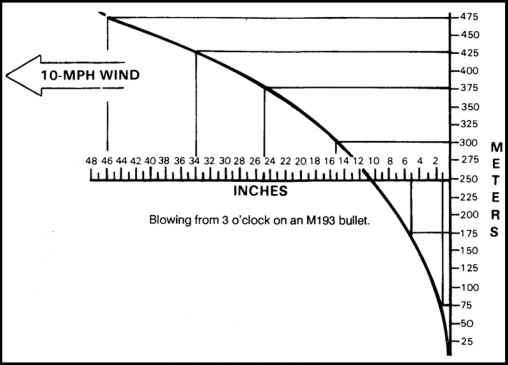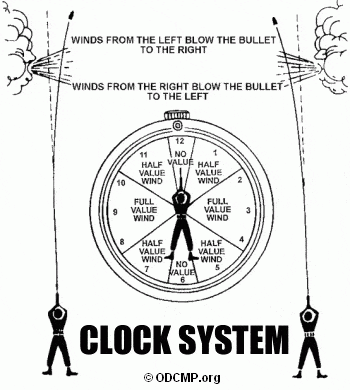You line up your target in your crosshairs…take a cleansing breath and exhale…squeeze slowly on the trigger…and then watch in frustration as your round sails harmlessly to the right and your prey scampers off! What happened?!
You, my unfortunate friend, may have failed to adjust for windage, and your bullet was pushed off course by wind as it traveled to the target. If you’ve ever found yourself in this situation, the good news is that it’s pretty easy to fix, and today we will help you learn how to adjust a scope for windage!
WINDAGE BASICS
Windage simply refers to the effect of the air or wind in deflecting a bullet from its intended path. It can occur any time you’re outside a controlled environment like an indoor range and should always be taken into account when hunting (or you may risk missing or even wounding an animal.)
You wouldn’t think that something as simple as the wind could affect a round’s trajectory, but the chart below shows just how much even a gust blowing at 10 mph can affect the accuracy of even an M193 (more commonly known as the 5.56 NATO round) bullet:
HOW TO ADJUST FOR WINDAGE
Unfortunately, while adjusting for windage isn’t terribly complicated in general, we’ll have to do a little math to get an understanding of it before you just start playing around with the windage turret on your scope.
If you’ve never heard of Minute Of Angle (MOA) before, here’s a quick primer: MOA is an angular measurement used to gauge how much to adjust bullet trajectory in precision long-range shooting. At 100 yards, 1 minute = 1 inch (and at 50 yards, 1 minute = ½ inch, and at 25 yards, 1 minute = ¼ inch, and so on.)
So let’s say you’re out on the range trying to hit a target 100 yards away. You line up your shot and fire, but notice that your bullet lands two inches to the right of bullseye. This indicates that the crosswind blowing from your left is pushing your bullet off course as it makes its journey to the target.
(Ignore the specifics of the above; it’s just a helpful visual in seeing how the round’s flight path is affected by windage.)
If your bullet is landing 2 inches off-target, you’ll want to adjust your windage turret, usually on the side of your scope (versus the elevation turret on top of your scope.)
To adjust your windage turret, take off the turret cap and turn it 2 “clicks” or hashes clockwise on a scope turret where 1 click is equal to 1 MOA. Chances are that your turret is not actually calibrated for where 1 click/hash = 1 MOA, as that would be a pretty intense adjustment, but usually there will be some indication either on the turret itself or on the inside of the cap that’ll tell you how much adjustment is relative to the click.
So, if your turret is calibrated where 1 minute = ¼ inch at a hundred yards (typical for many turrets), you’d turn it 8 clicks clockwise to adjust for the 2 inches of windage affecting your bullet trajectory.
Pro-tip: always finish with turning your turret in a clockwise direction, as this will ensure your scope is making good contact with the adjustment springs inside the mechanism interfacing with your turrets. This will also eliminate the need to rap on the scope to ensure that it’s fully seated–it’s a common practice for shooters to tap their rifle butt on the ground or tap their scopes with a spent casing to ensure the newly adjusted turrets are fully seated, but this isn’t healthy for your scope anyway and is remedied just as easily by always finishing with a clockwise turn.
SO! If you need to go several clicks counter-clockwise, go a few clicks past where you need to go, then land on the correct click by readjusting clockwise. For example: if adjusting 4 clicks counter-clockwise, actually go 6 clicks counter-clockwise, then back 2 clicks clockwise so you’re both ending on a clockwise turn and ending in the right click. After making these adjustments, you’re now ready to fire again!
One last pro-tip as you’re fine-tuning for windage: whichever turret you adjust first (windage or elevation) will limit the amount of adjustment you can make with your other turret because of how your scope’s designed.
For example, if after firing you find that you need to adjust 4 inches right for windage and 2 up for elevation, you’ll want to adjust for windage before adjusting for elevation. This may sound a little confusing, but just remember, “furthest first”–whichever direction you’re out furthest, move your scope in that direction first.
A NOTE ON “KENTUCKY WINDAGE”
Manually adjusting for windage (aka “Kentucky windage”) is when instead of adjusting your turret for windage, you physically aim left or right of center (so that your crosshairs are off-target.) For example, if you noticed that your bullet was hitting two inches left of bullseye and you used Kentucky windage to adjust, you’d readjust your next shot using manual holdover by physically aiming to the right.
This is obviously much trickier as you’re basically guessing instead of adjusting your scope, but some people are practiced enough that they are extremely accurate using Kentucky windage, and some reticles are designed with horizontal holdover points to help you do this more accurately.
Conclusion
Windage can be a fearsome foe when it comes to hitting long-range targets in rough environmental conditions, but with modern technology or good ole-fashioned Kentucky windage estimations it is possible to overcome this adversary and get accurate shots downrange and on-target in the worst weather.
If you utilize the tips in this article and put a little work into understanding how the MOA adjustment of your rifle’s windage turret works, we are sure you’ll be firing accurately in adverse conditions and bringing home dinner in no time.
If you enjoyed this article you’ll probably like these:





